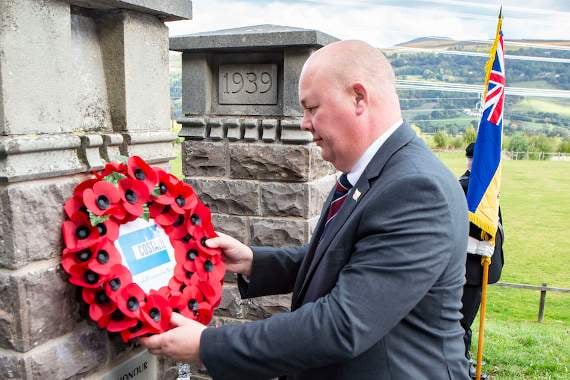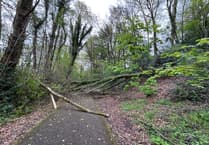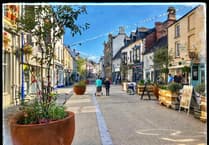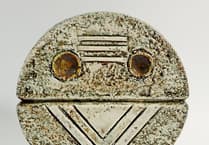ON a cold and still September morning a minute’s silence was held in Govilon for those from the village who had fallen in conflict during World War One and Two.
People gathered in the pale Autumn sunlight not just to pay their respects to the deceased but to also mark the completion of the refurbishment of the Govilon War Memorial Gardens.
During the outbreak of the Great War in 1914 a group of volunteers from Govilon signed up to fight for King and Country. They left the only home they’d ever known together via a horse-drawn carriage which departed from the village Post Office.
Waved goodbye by proud family and friends the local lads enlisted with "A" Company of the 3rd Battalion of the Monmouthshire Regiment.
They had no idea what sort of horrors awaited them on the other side of the English Channel.
By the time the guns were silent and the screaming had stopped the industrial bloodbath that was the First World War had claimed around 40 million lives.
Every corner in Britain no matter how quiet or remote had been touched by this terrible conflict. Govilon lost 12 of her youngest and best. They were killed in France, they were killed in Turkey and at least four of the lost their lives during the bloody Battle of Ypres. In that Belgium bloodbath, only 29 of the 500 men in ‘A’ and ‘D’ Company of the 3rd Mons who arrived in France on February 1915 survived.
Ivan Beatty, the major driving force behind the recent refurbishment told the Chronicle, “War Memorials stand at the heart of virtually every community in the United Kingdom. Not only are they a poignant reminder of the scale of losses ensured by the people in two World Wars and numerous other conflicts, but collectively in many cases, they are also a spectacular legacy of art and sculpture. They were the result of a spontaneous and emotional response by bereaved families and communities on a scale never likely to be repeated.”
The Govilon Memorial is made from red sandstone sourced from the local quarry. Although originally situated in the centre of the village it was re-sited from Pen-y-Bont in 1937 where houses were to be built. It now provides an impressive entrance to the King George V Recreation Ground at the western entrance of the village.
The Govilon Memorial is an unusual design but it is also unusual in that it commemorates a civilian casualty – May Prosser. May died on April 5, 1917, as a result of her work in a munitions factory. She was 26-years-old.
A further plaque was added to remember the two men from Govilon who died in the Second World War.
The Memorial benefitted from some improvements in 2005 when trees were felled and the sports field leveled. Sadly funds ran out before any further improvements could be made.
Ivan added, “In 2015 after discussions with the Community Council, Costain was approached to see if they could assist in making the Memorial more maintenance free and generally refurbish the whole area. They agreed to place the project on their assist the community programme and it has taken time to pull all the departments and resources together but the finished results are proof of the dedication of all concerned.
“With this in mind, I’d like to thank Costain’s Bruce Richards (Project Director), Lee Piper (Senior Construction manager), Jeff Mapps (Public Liaison Officer), and the boys on the ground who actually did the work.
“I’d also like to thank Adrian Phillips of Black Mountain Quarries for supplying four Forest of Dean stone plaques at no cost. National Grid for the donation of £240 for the four garden troughs.
RW Evans Monument maker in Brecon for the engraving of the four stone plaques at an extremely reasonable price. Thames Valley construction for their donation of £300. Abergavenny Morrison’s who supplied compost, plants, and assistance with tea and cakes after the ceremony. Mr. Michael Hay for securing troughs in the garden and helping in trimming the tree ready for removal.
“Also thank-you to Mr. Geoff Nash and Mr. Gerald Bright the RBL Standard Bearers.
“And lastly Llanfoist Fawr Community Council for underwriting the cost of the monumental mason work on the four stone tablets.”
Simon Chandler, National Grid Project Manager, told the Chronicle, “National Grid is always looking for opportunities to invest in the communities in which we work, and we’re grateful for the chance to help renovate the Govilon War Memorial Gardens. Honouring the memory of the fallen is an important cause and we’re very happy to commit a legacy to the community of Govilon whilst we work in the area”.
MP David Davies who was in attendance on the day said, “I would like to congratulate Ivan and everyone else who has worked so hard to restore this War Memorial. Govilon is fortunate to have such a unique and striking Memorial and like all Memorials, it is vitally important they are preserved so future generations can learn about and honour the men and women who fought and fell in the conflict.”
Ivan explained, “Unfortunately so many War Memorials have become neglected and forgotten over the years but it’s wonderful to see our memorial back in good condition and providing a fitting tribute to the sacrifice that the young residents of Govilon such as Basil Amyes, William Eastup, William Miller, Reginald Sheen, Brynley Evans, William Davies, Wilfred Jones, Godfrey Morgan, Thomas Smith, Harry Phillips, Percy Davies, George Matthews, Edward Morgan, and May Prosser. gave in the First and Second World Wars. May they rest in peace.”





Comments
This article has no comments yet. Be the first to leave a comment.